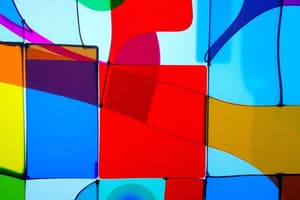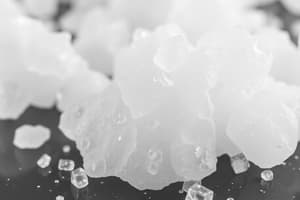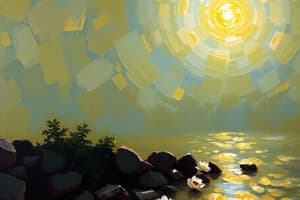Podcast
Questions and Answers
Which raw materials are combined and melted at high temperatures to produce glass?
Which raw materials are combined and melted at high temperatures to produce glass?
- Sand, soda ash, and limestone (correct)
- Limestone, alumina, and fining agents
- Soda ash, dolomite, and fining agents
- Silica, dolomite, and alumina
Which component of glass functions to lower the melting point of silica during production?
Which component of glass functions to lower the melting point of silica during production?
- Soda ash (Na2CO3) (correct)
- Limestone (CaCO3)
- Dolomite (MgO)
- Alumina (Al2O3)
In what percentage range is silica typically found in the composition of glass?
In what percentage range is silica typically found in the composition of glass?
- 5-12%
- 70-75% (correct)
- 12-15%
- 0.5-2%
Which type of glass is specifically designed to enhance safety by shattering into small, blunt pieces?
Which type of glass is specifically designed to enhance safety by shattering into small, blunt pieces?
What primary benefit does laminated glass offer in addition to safety?
What primary benefit does laminated glass offer in addition to safety?
Which glass type is commonly utilized to create privacy screens in bathrooms and offices by obscuring direct visibility?
Which glass type is commonly utilized to create privacy screens in bathrooms and offices by obscuring direct visibility?
In which application is mirrored glass most commonly used to enhance the perception of space?
In which application is mirrored glass most commonly used to enhance the perception of space?
What feature distinguishes smart glass (electrochromic glass) from other types of glass?
What feature distinguishes smart glass (electrochromic glass) from other types of glass?
What additional benefit does textured and wired glass offer besides visual appeal?
What additional benefit does textured and wired glass offer besides visual appeal?
Which characteristic of glass allows for natural light penetration, creating open and airy spaces?
Which characteristic of glass allows for natural light penetration, creating open and airy spaces?
Which property of engineered glass types enhances safety and resistance in interior spaces?
Which property of engineered glass types enhances safety and resistance in interior spaces?
What benefit does glass provide when used in partitions and walls, especially in office and home settings?
What benefit does glass provide when used in partitions and walls, especially in office and home settings?
What role do mirrors play in interior design, particularly within residential and commercial spaces?
What role do mirrors play in interior design, particularly within residential and commercial spaces?
How do glass elements in furniture and fixtures contribute to the overall design aesthetic?
How do glass elements in furniture and fixtures contribute to the overall design aesthetic?
In the context of interior design, what function do stained glass, back-painted glass, and textured glass serve?
In the context of interior design, what function do stained glass, back-painted glass, and textured glass serve?
What benefit do glass doors and windows primarily offer in interior spaces concerning light and visual aspects?
What benefit do glass doors and windows primarily offer in interior spaces concerning light and visual aspects?
In what specific areas are shower enclosures and balustrades utilized for safety, privacy, and elegance?
In what specific areas are shower enclosures and balustrades utilized for safety, privacy, and elegance?
What term is used to describe the system where glass facade units are pre-manufactured in a factory and assembled on-site to create exterior walls?
What term is used to describe the system where glass facade units are pre-manufactured in a factory and assembled on-site to create exterior walls?
In which glass cladding system are smaller, varied-size units installed onto pre-attached frameworks on a building's structure?
In which glass cladding system are smaller, varied-size units installed onto pre-attached frameworks on a building's structure?
What is a key characteristic of the stick system curtain wall method?
What is a key characteristic of the stick system curtain wall method?
Which cladding system results in clearly visible horizontal and vertical lines on the facade due to its assembly method?
Which cladding system results in clearly visible horizontal and vertical lines on the facade due to its assembly method?
Which glass assembly method is favored for its minimal structure that maximizes transparency?
Which glass assembly method is favored for its minimal structure that maximizes transparency?
What effect does positioning an object closer to a convex mirror have on its image?
What effect does positioning an object closer to a convex mirror have on its image?
What impact do frameless glass partitions have on interior spaces, and where are they commonly applied?
What impact do frameless glass partitions have on interior spaces, and where are they commonly applied?
Which type of glass is gaining traction in modern design for its ability to lower environmental impact?
Which type of glass is gaining traction in modern design for its ability to lower environmental impact?
Which emerging trend in glass design integrates touchscreen and LED technology?
Which emerging trend in glass design integrates touchscreen and LED technology?
What is the primary benefit of using hydrophobic coatings on self-cleaning glass?
What is the primary benefit of using hydrophobic coatings on self-cleaning glass?
What advantage does 3D-printed glass offer over traditional glass manufacturing methods?
What advantage does 3D-printed glass offer over traditional glass manufacturing methods?
Regarding images in a flat (plane) mirror, what is true of the distance between the image and the mirror, compared to the distance between the object and the mirror?
Regarding images in a flat (plane) mirror, what is true of the distance between the image and the mirror, compared to the distance between the object and the mirror?
Flashcards
What is Glass?
What is Glass?
A non-crystalline, amorphous solid composed of silica, soda ash, and limestone melted at high temperatures.
Clear Glass
Clear Glass
Standard glass offering transparency and permitting light flow.
Tempered Glass
Tempered Glass
Heat-treated glass that shatters into small, blunt pieces for safety.
Laminated Glass
Laminated Glass
Signup and view all the flashcards
Frosted & Etched Glass
Frosted & Etched Glass
Signup and view all the flashcards
Stained & Colored Glass
Stained & Colored Glass
Signup and view all the flashcards
Mirrored Glass
Mirrored Glass
Signup and view all the flashcards
Smart Glass
Smart Glass
Signup and view all the flashcards
Textured & Wired Glass
Textured & Wired Glass
Signup and view all the flashcards
Glass Transparency
Glass Transparency
Signup and view all the flashcards
Glass Durability
Glass Durability
Signup and view all the flashcards
Acoustic Insulation
Acoustic Insulation
Signup and view all the flashcards
Glass Versatility
Glass Versatility
Signup and view all the flashcards
Glass Sustainabilty
Glass Sustainabilty
Signup and view all the flashcards
Glass Partitions & Walls
Glass Partitions & Walls
Signup and view all the flashcards
Glass Fixtures
Glass Fixtures
Signup and view all the flashcards
Decorative Features
Decorative Features
Signup and view all the flashcards
Glass Doors & Windows
Glass Doors & Windows
Signup and view all the flashcards
Shower enclosures
Shower enclosures
Signup and view all the flashcards
Panelized Curtain Wall
Panelized Curtain Wall
Signup and view all the flashcards
Unitized Curtain Wall
Unitized Curtain Wall
Signup and view all the flashcards
Stick System
Stick System
Signup and view all the flashcards
Bimodular Curtains
Bimodular Curtains
Signup and view all the flashcards
Bolted Glass Assemblies
Bolted Glass Assemblies
Signup and view all the flashcards
Mirror Benefits
Mirror Benefits
Signup and view all the flashcards
Mirror Styles
Mirror Styles
Signup and view all the flashcards
Mirror applications
Mirror applications
Signup and view all the flashcards
Sustainable Glass
Sustainable Glass
Signup and view all the flashcards
Glass Interaction
Glass Interaction
Signup and view all the flashcards
3D-Printed Glass
3D-Printed Glass
Signup and view all the flashcards
Study Notes
- Glass is valued in interior design for its aesthetic appeal, ability to manipulate light, and versatility in functional and decorative applications.
- Glass is a non-crystalline, amorphous solid composed of silica (SiO2).
- It is obtained by melting sand, soda ash, and limestone at extremely high temperatures, then cools rapidly, preventing crystallization.
- This process results in a transparent, translucent, or opaque material with unique physical and chemical properties.
Glass Component
- Silica makes up 70-75% of glass and is its main component.
- Soda ash makes up 12-15% of glass and lowers the melting point of silica.
- Limestone makes up 5-12% of glass, stabilizing it and improving durability.
- Dolomite makes up 2-5% of glass and provides magnesium oxide for chemical resistance.
- Alumina makes up 0.5-2% of glass and provides aluminum oxide for chemical resistance.
- Fining agents, such as SO3 and Cl2, are used in small amounts to remove bubbles from glass.
Types of Glass
- Clear glass is a standard variety used for windows, doors, and tabletops, which offers transparency and light flow.
- Tempered glass is heat-treated for safety, shattering into small, blunt pieces instead of sharp shards instead.
- It is used in partitions, doors, and shower enclosures.
- Laminated glass consists of two layers bonded with a plastic interlayer for added safety and sound insulation.
- It can be used in skylights, railings, and display cases.
- Frosted and etched glass is treated to create aesthetic patterns or privacy screens in bathrooms and offices.
- Stained and colored glass adds an artistic touch with vibrant hues and intricate designs.
- It is often used in windows, wall panels, and decorative elements.
- Mirrored glass enhances space perception, making interiors feel larger and brighter.
- It is commonly found in retail stores, living rooms, and hallways.
- Smart glass (electrochromic glass) switches between transparent and opaque for privacy control and energy efficiency in high-tech interiors.
- Textured and wired glass provides visual appeal and additional strength, for partitions and decorative features.
Key Properties
- Glass is widely used in architectural and interior spaces due to its characteristics.
- It provides transparency and light transmission, allowing natural light penetration and creating open, airy spaces.
- Engineered glass types such as tempered and laminated glass enhance safety and resistance.
- Advanced glazing techniques improve energy efficiency and soundproofing.
- Aesthetic versatility in finishes, colors, textures, and patterns for different design styles.
- Glass is sustainable and recyclable, which can be repurposed and integrated into eco-friendly designs.
Applications of Glass in Interior Spaces
- Glass plays a crucial role in modern interior design.
- Frameless glass partitions creates an open yet private space in offices and homes.
- Mirrors are used to enhance depth, brightness, and aesthetics in residential and commercial interiors.
- Glass elements in tables, shelving, cabinetry, and lighting offer a sleek, contemporary look.
- Stained glass, back-painted glass, and textured glass serve as artistic focal points in interiors.
- Glass doors contribute to visual continuity, while windows allow for daylighting and energy efficiency.
- Shower enclosures and balustrades are utilized for safety, privacy, and elegance in bathrooms and staircases.
Glass Partitions and Walls
- Benefits include open layouts, soundproofing, and privacy when frosted or textured.
- Frameless partitions offer a minimalist aesthetic for modern spaces.
- They are applied in offices, retail stores, and residential interiors.
Glass Furniture
- Versatility in design can be seen with coffee tables, shelving units, and consoles, which are modern furniture showcasing glass and metal combinations.
Applications of Cladding Systems
- Cladding systems are different methods for applying glass facades or walls, whether interior or exterior.
- Panelized curtain walls are designed from large manufactured panels, weight up to 1.5 tons, calculated based on vertical structure width, installed by technicians and sealed with silicone.
- Unitized curtain walls are similar to panelized systems but with varying sizes, manufactured and installed on site.
- Stick system curtain walls use vertical mullions and horizontal transoms assembled on site, then filled with glass and sealed.
- Bimodular curtain walling involves pre-assembled units attached to the structure with visible horizontal and vertical lines, sealed with silicone.
- Bolted glass assemblies (spider system) directly attach glass panels to a structure with bolts, offering high transparency and common in commercial spaces.
Mirrors in Design
- Mirrors feel larger, brighter, and dynamic.
- Mirror types include antique, framed, frameless, and custom shapes. -The image appears the same size in a flat mirror.
- Applications include hallways, bedrooms, and commercial interiors. -If the obect moves coser to a concave irror, the image appears larger.
- If the obect moves closer to a convex irror, the image appears smaller and farther away.
Emerging Trends
- Sustainable glass means increased use of recycled and energy-efficient glass to reduce environmental impact.
- Interactive glass means touchscreen-enabled and LED-embedded glass for high-tech smart homes and workplaces.
- 3D-printed glass has revolutionary designs with customized textures and complex structures.
- Self-cleaning glass refers to hydrophobic coatings that prevent dirt accumulation, reducing maintenance.
Conclusion
- Glass enhances interiors with beauty, functionality, and innovation.
- Boundaries of traditional design can be pushed with creative uses of glass.
- Emerging technologies should be embraced for sustainable and smart solutions.
- Aesthetics, functionality, and sustainability can be combined.
- Spaces can be transformed with light and transparency.
Studying That Suits You
Use AI to generate personalized quizzes and flashcards to suit your learning preferences.




